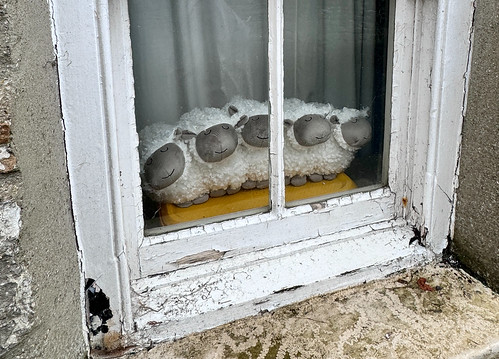According to Wikipedia, the Yorkshire Dales are "a series of valleys, or dales, in the Pennines, an upland range in England." The majority of the dales are within the Yorkshire Dales National Park. I have visited the Yorkshire Dales twice. In 2019, I participated in an animal photography tour. We stayed at Kiplin Hall. I participated in a "sheep safari" this year (2024). We stayed at a house in Reeth.
James Alfred Wight, better known by his pen name James Herriot was a veterinary surgeon and author. He practiced veterinary medicine in the Yorkshire Dales for almost 50 years. He is best known for writing a series of 8 books set in the 1930-1950s. I read them all when I was a kid and have re-read (as an adult) the stories as they've been published in different collections. There have been several TV and film adaptions of his books. I visited the World of James Herriot (in Thirsk) for the second time. The place has been updated to include the new TV series, of which I am a big fan.
Hawes
Winding roads


Buttertubs Pass is a high road in the Yorkshire Dales. The "tubs" are a cluster of limestone potholes. It is believed that the name came from Swaledale farmers who would travel the route to bring their produce to market. Many would bring cheese and butter to sell, but what they didn't sell they would lower down in baskets on long ropes into the potholes to keep cool.
Dry stonewalls are frequently used as boundaries in the highlands. Their use dates back to the iron age. They are living history. The stone walls are not held together with cement or mortar. The way the stones are placed holds them in place. When stonewalls are in disrepair, they are usually rebuilt. They are not replaced with fences. In fact, you are not supposed to take down dry stonewalls. You can hire people to build or repair the stonewalls or do it yourself. Sometimes, there is fence wire on top of the dry wall.
Dry walls
Field barns are also a part of the landscape of Yorkshire Dales. They were used for cow housing and fodder storage. They are also called cow-houses. Sometimes, the barns housed sheep.
The Swaledale is the most numerous sheep in the Yorkshire Dales. It is hardy breed known for its ability to raise lambs under harsh conditions. The breed has distinct markings: a blackface with white around its eyes and nose. Both sexes have curly horns. Wool quality isn't very good. The sheep are shorn for animal welfare reasons. It is not customary to dock Swaledales. The long, woolly tails offer protection from the exposed conditions of the sales. After four years, Swaledale ewes are brought to the lowlands to produce Mule ewes, via crossing with Bluefaced Leicester rams.
Stream
The Ribblehead Viaduct is a famous Yorkshire landmark. It was built in the 1870's. The viaduct has twenty-four arches that carry the railway line 104 feet above the moor. We walked to the base of the viaduct. There were many sheep nearby. Sheep are everywhere in the Yorkshire Dales. We got to see a train cross. That was cool.
Ribblehead Viaduct
Ruskin's View is an unspoiled countryside view celebrated by 19th century critic and poet John Ruskin. It is near St. Mary's Church in Kirkby Lonsdale. The entrance to the view was closed when we visited, due to safety concerns. We went over the gate. We couldn't pass up the opportunity to see the view called "one of the loveliest in England, therefore the world." How does Edwin find these spots?






















No comments:
Post a Comment